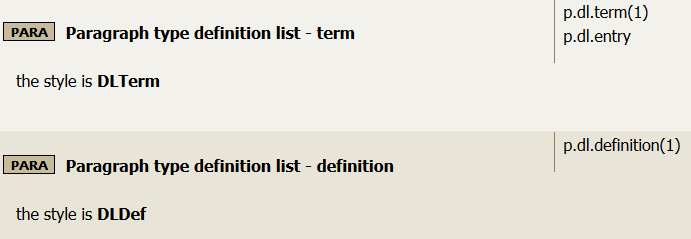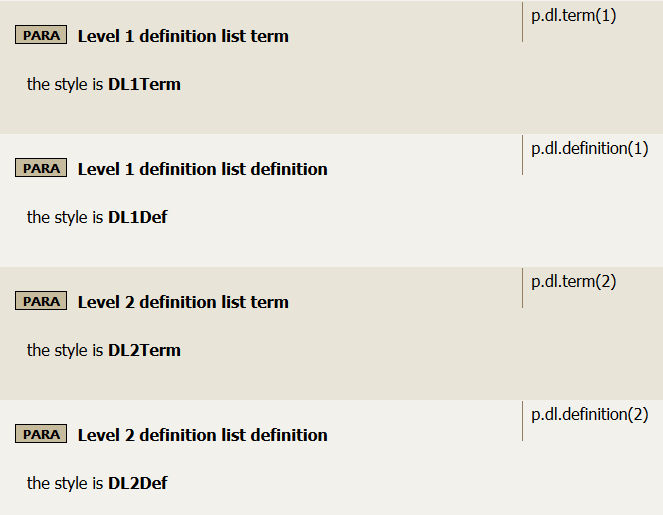Syntax #
p.dl.entry
p.dl.head
p.dl.term(level)
level
nesting level for the list, any integer
p.dl.definition(level)
level
nesting level for the list, any integer
Purpose #
A definition list is a list of terms and corresponding definitions.
Here is a sample list with a header:
Term – Definition
IO
Input Output
FIFO
First In First Out
LIFO
Last In First Out
SQL
Structured Query Language
TTY
Teletype
Since the terms and definitions are in different paragraphs, you will need to use the annotations p.dl.term() and p.dl.definition() to mark up the paragraphs. You can also use the annotation p.dl.head for the header line.
This is what your rules may look like.
Your output may look like this.
<dl>
<dlhead>
<dthd>Term - Definition</dthd>
</dlhead>
<dlentry>
<dt>IO</dt>
<dd><p>Input Output</p></dd>
</dlentry>
<dlentry>
<dt>FIFO</dt>
<dd><p>First In First Out</p></dd>
</dlentry>
<dlentry>
<dt>LIFO</dt>
<dd><p>Last In First Out</p></dd>
</dlentry>
<dlentry>
<dt>SQL</dt>
<dd><p>Structured Query Language</p></dd>
</dlentry>
<dlentry>
<dt>TTY</dt>
<dd><p>Teletype</p></dd>
</dlentry>
</dl>
Definition lists can also be nested, as in this example below.
Computer peripherals
Electronic equipment connected, usually by cable, to the CPU of a computer. Such devices include:
Keyboard
A set of keys used to input text and numbers into a computer.
Mouse
A hand-controlled pointing device that detects two-dimensional motion
Monitor
A screen on which the computer’s output is displayed
Touchscreen
A touch-sensitive screen that can act as both input and output for a system
CPU
Central Processing Unit
This is what your rules may look like.
This is what your output may look like.
<dl>
<dlentry>
<dt>Computer peripherals</dt>
<dd><p>Electronic equipment connected, usually
by cable, to the CPU of a computer. Such devices include:
</p>
<dl>
<dlentry>
<dt>Keyboard</dt>
<dd>
<p>A set of keys used to input text and
numbers into a computer.</p>
</dd>
</dlentry>
<dlentry>
<dt>Mouse</dt>
<dd>
<p>A hand-controlled pointing device that detects
two-dimensional motion</p>
</dd>
</dlentry>
<dlentry>
<dt>Monitor</dt>
<dd>
<p>A screen on which the computer’s output is displayed</p>
</dd>
</dlentry>
<dlentry>
<dt>Touchscreen</dt>
<dd>
<p>A touch-sensitive screen that can act as both input
and output for a system</p>
</dd>
</dlentry>
</dl>
</dd>
</dlentry>
<dlentry>
<dt>CPU</dt>
<dd>
<p>Central Processing Unit</p>
</dd>
</dlentry>
</dl>






